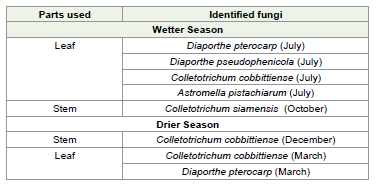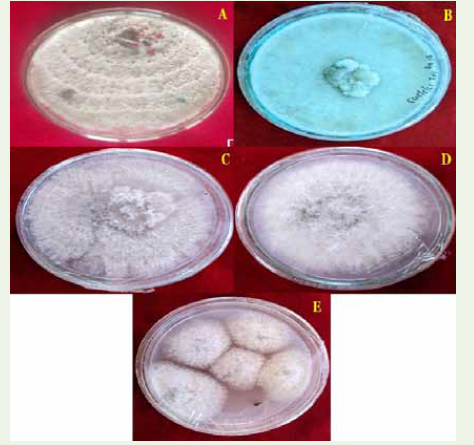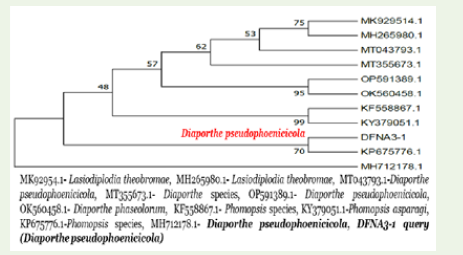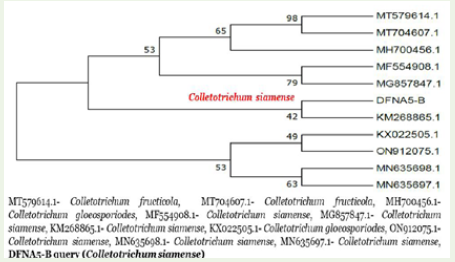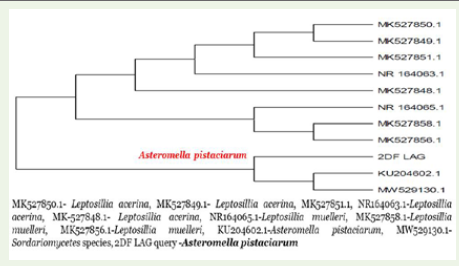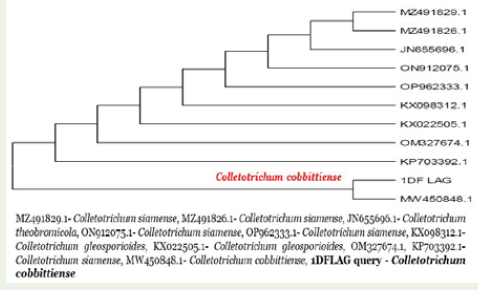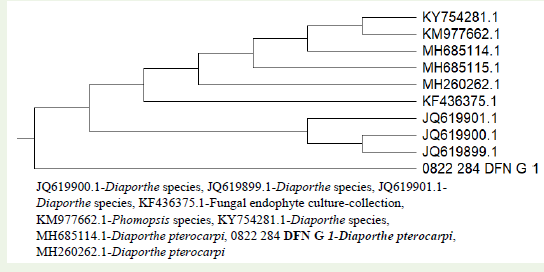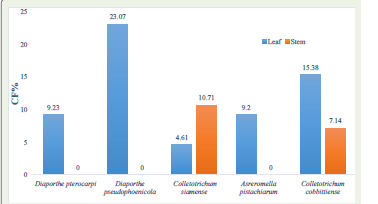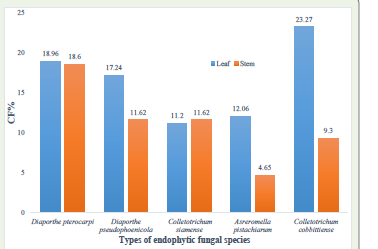Research Article
Isolation and Characterization of Endophytic Fungi from the Parasitic Plant Dendrophthoe falcata
Hemamalini S, Vatsala P, Monisha CP, Manasa DJ and Govindappa M*
Department of Studies in Botany, Davanagere University, Shivagangotri, Davanagere, Karnataka, India
*Corresponding author: Govindappa M, Department of Studies in Botany, Davanagere University, Shivagangotri, Davanagere, Karnataka, India. Email Id: govindappa.dubot@gmail.com
Copyright: ©Hemamalini S, et al. 2024. This is an open access article distributed under the Creative Commons Attribution License, which permits unrestricted use, distribution, and reproduction in any medium, provided the original work is properly cited.
Article Information:Submission: 22/07/2024; Accepted: 24/08/2024; Published: 30/08/2024
Abstract
The present study aimed to identify, characterize and diversity in two season of endophytic fungal species from parasitic plant, Dendrophthoe falcata grows on Lagerstromia speciosa. The mass cultured pure endophytic fungal species identified using molecular technique 18S rRNA and studied the percentage frequency studies. Based on the results identified endophytic fungal species are Diaporthe pterocarp, Diaporthe pseudophenicola, Colletotrichum cobbittiense, Astromella pistachiarum and Colletotrichum siamensis. These endophytes noticed from two different parts (leaves and stem) in two different season (wet and dry). The percentage frequency studies of each endophytes were different and deposited endophyte sequences in NCBI. These endophytes used for isolation of bioactive compounds and their biological studies..
Keywords:Dendrophthoe falcate; endophytic fungi; 18S rRNA; colony frequency
Introduction
Dendrophthoe falcata is a hemiparasitic plant belongs to
Loranthaceae and it is most common in India. The D. falcata reported
on many host plants viz., Sugar Apple, Sapota, Guava, Pomegranate,
Mango, Myristica, Artocarpus, Neem and many plants. The D. Falcata
possessing properties of wound healing, antimicrobial, antioxidant
and antinociceptive [1,2]. The plant is also using to treat tuberculosis,
asthma, menstrual disorders, wounds, ulcers, renal problems [3,4],
anticancer activity[5]. Many biologically important bioactive
compounds were identified they are steroids, sesquiterpenoids,
pentacyclic triterpenoids, flavonoids, hydrocarbons, carboxylic acids,
phenols and tannins, esters, alcohols, glycosides, triglycerides, enzymes
and they exhibited antitumor, hepatoprotective, antihyperlipidimic,
thrombolytic, antioxidant, antidiabetic, antibiofilm, cytotoxic,
anxiolytic, antifungal, immunostimulatory activities [6]. Nigrospora
sphaerica [7], Pestalotiopsis species [8], Alternaria alternata [9] are reported as endophytic fungi of D. falcata. Based on the literature,
the present research was aimed to survey for D. Falcate on different
host in identified area and identification of endophytic fungi from D.
Falcate was carried out in two season collected samples. Endophytic
fungi possessan wide variety of applications include, protection
against diseases caused by pathogenic microorganisms, protection
against herbivory, plant growth promotion, production of secondary
metabolites, secondary metabolites of biotechnological interest,
endophytic fungi as biological control agents of phytopathogens etc
[10].
Significance of endophytic fungi of parasitic plants includes,
Increase the nutrition absorption from soil [11], enhances the
abiotic stress tolerance [12], increases the production of secondary
metabolites and plant hormones[13], endophytic fungi protect the
host plant from biotic stress by opposing the pest and pathogen which
disturb the plant defense mechanisms [14].
Materials and Methods
Collection of plant: To collect the parasitic plant parts two different seasons was selected (wet and dry season) and collected
plant parts viz., leaves and stem of Dendrophthoe falcata. The plant
was collected from the host Lagerstromia speciosa was used for
the present study. Dendrophthoe falcata is a common parasitic
plant found on a variety of hosts including native and introduced
species. Dendrophthoe falcata is known to parasitize a wide range
of host plants. While studies have focused on its primary hosts,
such as Mangifera indica (mango) and various timber trees [15],
there is limited evidence specifically addressing its interactions with
Lagerstroemia species as a host. Prior research typically identifies
other common hosts and documents the ecological and economic
impacts of D. Falcate on those species [16]. Given the lack of extensive
research explicitly linking Dendrophthoe falcata to Lagerstroemia
species, this host plant which was available in the Devarayanadurga
area was chosen. An understanding of how D. Falcate interacts with
Lagerstroemia not only contributes to knowledge in Botany but could
also reveal insights into the endophytic community that resides within
hemiparasitic plants like Dendrophthoe [15,16]. The plant was dried
and made herbarium and identified the plant Dendrophthoe falcata
by Dr Haleshi C, Taxonomist (Voucher no.HDUD304) by making
herbarium. The separated stem and leaves were thoroughly washed
with running tap water, and then the stem and leaves were surface
sterilized with 70% ethanol by dipping for 30 seconds followed by 2%
sodium hypochlorite for 30 seconds later rinsed in sterilized distilled
water to remove excess of ethanol and sodium hypochlorite. The stem
and leaves were dried using sterilized filter paper on a Petri plates.
Using sterilized surgical blade, the leaves and stem were cut into 1 to
1.5 cm pieces and carefully placed it on Potato Dextrose Agar (PDA)
media containing Petri plates aseptically. The plates were incubated at
room temperature (26+20C) for 8-10 days and plates were routinely
observed for the development of hyphae from incubated parts. The
grown fungi from incubated parts were isolated and subjected to
mass culture and stored at 40C.
Mass culture of endophytic fungal species:
Each endophytic fungal species were grown from incubated parts
were carefully transferred to PDA containing Petri plates and Potato
Dextrose Broth (PDB) containing conical flasks to obtain pure culture
by incubating at room temperature (26+20C) for 8-10 days.Identification of endophytic fungi:
Each endophytic fungal species were identified based
morphological characters such as colony morphology, pigmentation,
growth pattern, hyphal characters and spore morphology using with
the help of standard fungal manuals [17-18].Molecular identification of isolated endophytic fungal species:
Totally 05 endophytic fungal species were selected for molecular
identification. The molecular identificationwas done using ITS1
and ITS 4 primers. 100 mg DNA was isolated from the culture.
Its quality was evaluated on 1.0% Agarose Gel and a single band
of high-molecular weight DNA was observed. A fragment of ITS
region was amplified by PCR. A single discrete PCR amplicon
band of 700 bp was observed when resolved on agarose. The PCR
amplicon was purified to remove contaminants. The forward and
reverse DNA sequencing reaction of PCR amplicon was carried
out with ITS1(5’-TCCGTAGGTGAACCTGCGG) and ITS4(5’-
TCCTCCGCTTATTGATATGC) primers using BDT v3.1 Cycle
sequencing kit on ABI 3730xl Genetic Analyzer. A consensus
sequence of the PCR amplicon was generated from forward and
reverse sequence data using aligner software. The ITS region sequence
was used to carry out BLAST with the database of NCBI Genbank.
Based on maximum identity score, first ten sequences were selected
and aligned using multiple alignment software program Clustal W.
The distance matrix was generated and the phylogenetic tree was
constructed using MEGA 7 [19].Percentage Frequency Studies:
Colonization frequency was calculated by dividing the number
of individual fungal endophytes recorded by the total number of
segments screened and then multiplying the result by 100. This
formula helps determine the percentage of plant tissue segments
colonized by fungal endophytes [20].Results and Discussion
Hemiparasitic plants were observed on several host trees
including Pongamia pinnata, Albizzia lebbeck, Lagerstroemia
speciosa, Nyctanthes arbor-tristis and Mangifera indica. The most
prominent hemiparasitic species were Scurrula sps, Dendrophthoe
gamblei, Viscum album and Dendrophthoe falcata during the survey
at Devarayana Durga region of Tumakuru (13.33790N, 77.11730E,
temperature range from 170C to 280C), Karnataka, India and survey
was conducted in January-March 2021 and September-December
2022. Dendrophthoe falcata was a common hemiparasite seen and
was chosen for isolation of endophytic fungi. The D. falcata grows on
Lagerstroemia speciosa was selected for the present study.
Leaf part of D. Falcate collected in wetter season yielded four
different endophytic fungal species viz., Diaporthepterocarp,
Diaporthepseudophenicola, Colletotrichum cobbittiense and
Astromella pistachiarum whereas stem part yielded one fungus
Colletotrichum siamensis. In drier season, the stem part exhibited the
presence of Colletotrichum cobbittiense whereas leaf part also showed
the presence of Colletotrichum cobbittiense and Diaporthepterocarp.
The Colletotrichum cobbittiense and Diaporthepterocarp were noticed
to presence in two seasons and present in both leaf and stem parts
[Table 1].
Isolated the endophytic fungi Alternariaalternata from
Dendrophthoe falcata and synthesized the silver nanoparticles
from Alternariaalternata extracts showed strong antibacterial and
antioxidant activity [9]. Seven different species of Diaporthe were
reported as endophytic fungi in Citrus [21].
Colletotrichum cobbittiense was reported as pathogen from
Cyanthilliumcinereum [22]. Colletotrichumcobbittiense was reported
as endophytic fungi from Pteridiumacquilinium and Newbouldialaevis
leaves [23]. The Colletotrichum siamensis reported as endophytic
fungi from Lycopersiconesculantum (Mill.) and exhibited the plant
growth promoting activities [24].
All the endophytic fungal species mass cultured on PDA media
and used for molecular identification studies [Figure 1]. Based the
sequence draw the phylogenetic tree using Mega 7 [Figure 2-6]. All the five different endophytic fungal species sequences (Colletotrichum cobbittiense (Accession number: PP159096),
Asteromellapistachiarum (Accession number: PP159099),
Diaporthepseudophenicola (Accession number: OR858835),
Colletotrichum siamensis (Accession number: OR827685) are
deposited in NCBI and expecting to submit Diaporthepterocarp.
Percentage Frequency Studies:
The diversity of endophytic fungal community was analysed
Figure 1:Pure culture of endophytic fungi isolated from leaves and stem parts of Dendrophthoe falcata, A- Diaporthe pterocarpi, B-Astromella pistachiarum, CDiaporthe pseudophoenicola, D- Colletotrichum siamense, E-Colletotrichum cobbittiense
from two different parts tissues. The diversity of isolated endophytic
microbes on different culture media can be examined through
non-(CF) for endophytic fungi can be determined manually
using the formula provided by Hata and Futai (1995) [20]: % CF=
(Ncol/ Nt) x 100, where molecular methods. Various approaches
can be employed to assess this diversity, including colonization
frequency, isolation frequency, and alpha diversity indices such
as Simpson’s and Shannon-Wiener diversity indices, as well as
measures of species richness and evenness[20,25,26]. Colonization
frequency Ncol represents the number of segments colonized by
each fungus and Nt denotes the total number of segments studied.
Based on the colonization frequency data, leaf samples showed
greater colonization for all the endophytic fungi isolated compared
to stem samples [Figure 7] [Figure 8]. Colletotrichumsiamense and
Colletotrichum cobbittiense were the two fungi isolated in the dry
season from the stem [Figure 7]. This signifies that the above two
species of endophytic fungi are common to both stem and leaf.
Further studies are suggested to confirm the same.Wetter seasons
favoured more diverse and abundant growth of fungal endophytes.
Similar results were observed from the earlier reports[27]. The reason
could be attributed to increased moisture, availability of nutrients in
the host plant, increased germination and growth rates. Rainwater
washes nutrients from the atmosphere and soil, enriching plant
tissues. These nutrients support both plant growth and endophyte
Figure 2:Molecular identification of endophytic fungal species, Diaporthe pseudophoenicola of D. falcata with phylogenetic analysis
Figure 3:Molecular identification of endophytic fungal species, Colletotrichum siamense of D.falcata with phylogenetic analysis.
Figure 4:Molecular identification of endophytic fungal species, Astromella pistachiarum of D. falcata with phylogenetic analysis.
Figure 5:Molecular identification of endophytic fungal species, Colletotrichum cobbittiense of D. falcata with phylogenetic analysis.
Figure 6:Molecular identification of endophytic fungal species, Diaporthe pterocarpi of D. falcata with phylogenetic analysis.
Figure 7:Colonization frequency of endophytic fungal species in dry season in two different parts of D. falcata.
proliferation[28]. Among all the endophytic fungal species, a total
number of 05 species obtained from the leaf and stem segments are
Diaporthepterocarpi (18.95%) (18.60%), Diaporthepseudophoenicicola
(17.24%) (11.62%), Colletotrichumsiamense (11.20%) (11.62%),
Asteromellapistaciarum (12.06%) (4.65%), Colletotrichum cobbittiense
(23.27%) (9.30%) respectively, and form the dry season a total number
of 05 endophytic fungal species obtained from leaf segment are
Diaporthepterocarpi (9.23%), Diaporthepseudophoenicicola (23.07%),
Colletotrichumsiamense (4.61%), Asteromellapistaciarum (9.20%),
Coletotrichum cobbittiense (15.38%) and from the stem segment of
02 endophytic fungal species obtained are Colletotrichumsiamense
(10.71%) and Colletotrichum cobbittiense (7.14%) [Figure 7] and
[Figure 8]. Our results are confirmation with the results of Verma et
al. (2007) [25] and Mitchell et al. (2020) [26].
Conclusions
The present study provides idea to know diversity of endophytic
fungi associated with hemiparasitic parasitic plant Dendrophthoe
falcata. Five different endophytic fungi were isolated and identified
by molecular techniques and they were isolated from two parts (leaves
and stem) in two seasons (wet and dry) separately. The literature on
endophytic fungi reveals that many endophytic fungi are producing
many secondary metabolites, which are biologically potent. Such
biologically important potent bioactive compounds can be produced
in high amount within short duration.
Acknowledgement
The authors sincerely thank VGST for funding for the present
study under KFIST-L1. We also express our sincere gratitude
to Department of Studies in Botany for providing facility and
encouragement.


